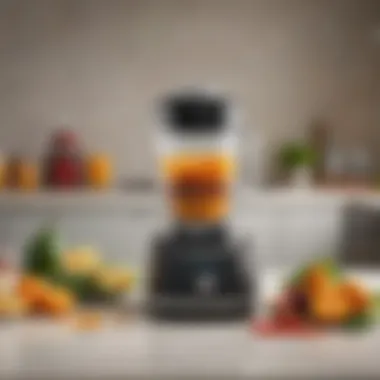The Ultimate Guide to Blender-Food Processors


Intro
In the realm of cooking, efficiency and versatility are paramount. With a myriad of kitchen appliances available today, the blender-food processor combination stands out as a powerful tool for culinary enthusiasts. These machines can perform numerous tasks, from blending smoothies to chopping vegetables. Understanding the features and functionalities of these devices is crucial for anyone looking to enhance their cooking experience.
Choosing the right blender-food processor can seem daunting. However, a well-informed decision can lead to countless culinary creations and time savings in the kitchen. This guide seeks to simplify the selection process by detailing the essential aspects to consider when purchasing these kitchen essentials. Readers will explore various types, notable brands, key features, and user testimonials, enabling them to make an educated choice that aligns with their specific culinary needs.
Ultimately, this article serves as a comprehensive resource for food lovers of all levels, helping them grasp the multifunctional capabilities of blenders and food processors. By the end, readers will be well-equipped to elevate their cooking skills and kitchen efficiency.
Prelude
In today’s culinary landscape, kitchen efficiency is paramount. For cooking enthusiasts, the choice between a blender and a food processor can profoundly affect meal preparation. Each of these appliances offers distinct features tailored to specific tasks. The emergence of the blender-food processor combo has become a popular solution for those seeking versatility without sacrificing functionality. This guide delves into the nuances of selecting the right appliance based on individual cooking habits and preferences.
Understanding the capabilities of both blenders and food processors helps in recognizing their essential roles in the kitchen. The combination of these two devices often leads to improved productivity, allowing users to tackle a wider range of recipes with ease. From smoothies to salsas, and from finely chopped vegetables to creamy soups, blending and processing can enhance meal variety.
Additionally, practical considerations such as space efficiency, budget constraints, and user skill level are crucial in this discussion. As kitchens often lack ample counter space, multifunctional appliances are favored for their ability to consolidate tools and minimize clutter.
Notably, this article aims to equip readers with in-depth knowledge of all aspects related to blender-food processor combinations. By exploring key features, popular brands, and common misconceptions, food lovers can make informed choices that elevate their culinary experience.
"The right kitchen appliance transforms cooking from a mere necessity into an enjoyable experience."
By examining the elements that matter most in a blender-food processor, readers are encouraged to assess their unique requirements. Ultimately, the goal is to empower cooking enthusiasts of all levels to select an optimal device that complements their culinary journey.
Understanding Blenders and Food Processors
Understanding the distinctions and functionalities of blenders and food processors is essential for anyone looking to enhance their culinary experience. While both appliances serve to simplify food preparation, they each have unique capabilities and are suited for different tasks. This section will clarify the basic functions of each, as well as the differences between them. By grasping these essentials, you can make informed decisions about which appliance or combination is suitable for your kitchen.
Basic Functions of a Blender
A blender primarily focuses on creating smooth liquids from solid ingredients. Common uses include:
- Smoothies: Blending fruits, vegetables, and liquids like yogurt or juice.
- Soups: Pureeing cooked ingredients into creamy textures.
- Sauces: Mixing and emulsifying ingredients for dressings and dips.
Blenders are equipped with sharp blades that rotate at high speeds. This makes them ideal for tasks that require slicing, chopping, or mixing. Most modern blenders come with various speed settings, allowing users to control the consistency of the blend.
Basic Functions of a Food Processor
On the other hand, a food processor functions as a versatile kitchen tool, capable of chopping, slicing, shredding, and mixing. Here are the fundamental roles:
- Chopping Vegetables: Quickly cutting vegetables into uniform pieces.
- Slicing Ingredients: Producing thin or thick slices for salads or casseroles.
- Making Dough: Combining ingredients efficiently for bread or pastry.
Food processors typically feature multiple attachments, including different blades and discs for various tasks. This versatility makes them indispensable for a wide range of culinary applications.
Differences Between the Two Appliances
While both blenders and food processors are kitchen aids, they are not interchangeable. Here are the key differences:
- Texture of Output: Blenders create smooth textures, making them ideal for liquids. Food processors can handle a variety of textures, from chunky to finely grated.
- Task Efficiency: Food processors can perform several functions, such as slicing and shredding, which a blender cannot do as effectively.
- Capacity: Food processors often have larger bowls, accommodating greater quantities of ingredients, whereas blenders are typically designed for smaller volumes suitable for beverages.
Overall, understanding these differences ensures that one can select the right appliance for specific cooking tasks, thus optimizing efficiency in the kitchen.
"Choosing the right appliance can dramatically change your approach to cooking, allowing efficiency and creativity to flourish."
By realizing the roles that each appliance plays, one can make confident decisions when it comes to their culinary tools.


Importance of Combining Functions
In today's fast-paced world, kitchen appliances that save time and space offer substantial advantages. A blender-food processor combo embodies this ideal, merging the functions of two essential cooking items into one. This integration brings efficiency to food preparation, making it a practical solution for numerous culinary tasks.
Combining functions allows for a streamlined approach to cooking. You can tackle various tasks, like chopping vegetables and blending smoothies, without needing multiple devices. As a result, this flexibility is especially beneficial for smaller kitchens where counter space is at a premium. By minimizing the number of appliances, one can create a cleaner and more organized cooking zone, which can enhance the cooking experience.
Moreover, utilizing a single appliance encourages culinary exploration. Users can easily experiment with a broader range of recipes. The convenience of having both capabilities in one unit also encourages creativity in meal preparation. Whether it’s making nut butter or pureeing soups, this combination opens new possibilities. It reduces the hassle of switching between different devices, letting you focus on flavors and techniques.
In summary, the importance of combining the functions of a blender and a food processor cannot be overstated. It optimizes kitchen efficiency and inspires culinary creativity. Let’s delve into two specific benefits of this integration.
Space Efficiency in the Kitchen
The modern kitchen often faces space constraints. Homes are getting smaller, but culinary aspirations continue to grow. A blender-food processor combination simplifies the kitchen layout. Instead of storing multiple appliances, you can consolidate your food prep tasks into one. This not only frees up counter space but also makes it easier to reach for your appliance without rummaging through cabinets.
Here are a few key aspects of space efficiency:
- Compact Design: Many of these combos have a compact design, fitting comfortably on most countertops.
- Fewer Utensils: Combining functions means fewer utensils and kitchen gadgets. A single bowl can serve multiple tasks.
- Easy Storage: Most models provide a simple method to store attachments and components, preventing clutter.
With limited space, investing in versatile tools is wise. A blender-food processor combo maximizes every inch in your kitchen.
Versatility for Diverse Recipes
Versatility is another significant advantage of having a blender-food processor. This combination allows cooks to tackle both simple and complex recipes with ease. From smoothies to salsas, the options are vast.
Here are some ways versatility shines:
- Multiple Functions: A single appliance can chop, blend, puree, and emulsify. This capability is crucial for creating diverse dishes.
- Recipe Adaptability: Whether you are making sauces, soups, or baked goods, adapting recipes becomes easier with just one device at your disposal.
- User-Friendly: Simplifying the cooking process helps novice cooks feel more confident. They can explore without worrying about managing different appliances.
Key Features to Consider
When selecting the perfect blender-food processor combination, key features play an essential role in shaping your kitchen experience. Understanding these features goes beyond superficial specifications; it is about how they align with your cooking habits, food preparation styles, and overall culinary goals. This section will examine the vital components you should consider, giving you the knowledge to make an informed purchase.
Motor Power and Speed Settings
The motor's power is often the backbone of any blender-food processor setup. A powerful motor significantly enhances its performance, allowing you to tackle more demanding tasks with ease. Consider a motor with at least 600 watts for effective blending and processing. However, more power does not always equate to better performance. The balance between motor power and the speed settings is equally crucial. Look for models that offer variable speed control. This allows for precise adjustments according to the texture and ingredients you are working with. For instance, a pulse setting can help achieve the desired consistency, especially when working with delicate ingredients.
Jar and Bowl Material
The material of the jar and bowl plays a significant role in durability, ease of cleaning, and food safety.
Glass vs. Plastic
Choosing between glass and plastic often sparks intense debate among culinary enthusiasts. Glass jars are weighty and tend to be more durable against wear over time. They are also non-porous; thus, they do not retain smells or stains from foods. This can be a huge plus for users who frequently blend strong-scented items like garlic or spices. However, glass is more fragile and, if dropped, could shatter. On the other hand, plastic jars are lighter and less likely to break. They are typically more impact-resistant, making them a practical choice for households with kids. But consider that lower-quality plastics may scratch or stain, potentially impacting their longevity.
Stainless Steel Options
Stainless steel provides an excellent alternative for those who prioritize durability and aesthetics. These bowls are robust and resistant to both stains and odors, making them suitable for preparing diverse recipes without cross-contamination of flavors. One notable feature of stainless steel is its non-reactive composition, which ensures it does not interact with acidic foods, such as tomatoes or citrus. However, they can be heavier and less transparent than glass or plastic, which might make it challenging to monitor progress while blending or processing.
Blade Design and Functionality
The design of the blades is crucial in determining how well your blender-food processor can chop, slice, puree, and blend. Different shapes and configurations can yield varying results. For example, wider blades tend to provide a more aggressive chopping action, while angled blades can help push food towards the center for even processing. Consider the material of the blades as well, with stainless steel being the most common choice due to its durability and sharpness. Look for models where blades are not only sharp but also easy to clean and maintain.
Size and Capacity
Now, the size of your appliance matters greatly. Depending on your cooking habits and the number of people you typically prepare meals for, the capacity of your blender-food processor should align with your needs. Smaller sizes may suit individuals or small families, while larger versions offer the benefit of tackling bigger batches for meal prep or entertaining. Keep in mind that larger appliances may require more storage space, so you need to balance your countertop area with your cooking volume.


Best Brands on the Market
Choosing the right brand can significantly influence the performance, durability, and functionality of a blender-food processor combination. The market offers a variety of brands that cater to different needs, preferences, and budgets. Knowledge of the best brands can help users make informed choices that will enhance their culinary experiences.
When considering brands, it is essential to evaluate several criteria such as reputation, product quality, customer support, and warranty. The best brands often invest in innovation, making appliances that not only perform well but also feature the latest technology in their designs. Users can benefit greatly from choosing a recognized brand that stands behind its products.
High-End Options
High-end brands typically feature robust construction, superior motor power, and versatile functionality. Brands like Vitamix and Blendtec are known for their high-performance blenders that seamlessly integrate processing capabilities. These appliances often come with advanced features such as programmable settings and self-cleaning options. Many professionals and serious home cooks prefer these brands due to their reliability and the outcomes they produce.
Investing in a high-end appliance often translates into longevity and excellent customer service. Users can expect higher prices, but this is generally offset by the quality and support they receive. For example, Vitamix appliances often come with a long warranty period, underscoring their commitment to customer satisfaction.
Mid-Range Choices
For those looking for quality without the complete financial commitment of high-end products, mid-range brands offer a compelling balance. Brands such as Ninja and Hamilton Beach provide excellent performance with a range of features at affordable price points. These appliances often cater to a broader audience and are suitable for everyday culinary needs.
Mid-range options typically provide good motor power and can handle a variety of tasks such as making smoothies, chopping vegetables, and preparing soups. They may lack some premium features but still offer durable and efficient performance. These brands often ensure that users do not sacrifice quality for cost, creating a solid entry point for cooking enthusiasts.
Budget-Friendly Alternatives
For many, budget constraints dictate appliance choices. Luckily, there are affordable options that do not compromise much on quality. Brands like Oster and Black+Decker are known for producing budget-friendly blenders and food processors that perform surprisingly well for the price.
While these appliances may not have the advanced features of their higher-priced counterparts, they are versatile and suitable for basic cooking needs. Users can expect decent build quality and essential functionalities for daily tasks. Consequently, for novice cooks or those who cook infrequently, these brands represent an excellent starting point.
"Investing in the right brand can save you time and enhance your cooking experience, making preparation efficient and enjoyable."
Selecting the best brand is not just about price; it involves understanding how often the appliance will be used and what functions are necessary. This is crucial for choosing the perfect blender-food processor combination that fits individual cooking needs.
User Considerations
When selecting a blender-food processor combination, understanding user considerations is crucial. This section analyzes various elements that affect how an individual may approach using these appliances. It provides insights tailored to different user profiles and highlights how personal cooking styles and preferences inform choices. Through this analysis, a user can make an informed decision that aligns with their cooking habits and goals.
Skill Level and Cooking Habits
Skill level has a direct impact on appliance choice. A seasoned chef will likely look for advanced features. They may prefer a high-powered blender, such as a Vitamix, capable of handling complex recipes. In contrast, novice cooks might favor simpler models with user-friendly interfaces. Beginner-friendly options typically offer preset programs for smoothies or soups, reducing the learning curve.
Cooking habits also come into play. Someone who regularly makes sauces, dips, and smoothies will need an appliance that excels in these tasks. If someone enjoys meal prep, a model with a larger capacity might be beneficial. Understanding personal habits can help pinpoint the model that best fits individual needs.
Frequency of Use
The frequency of use defines the long-term value of a blender-food processor combo. Those who cook daily should invest in a durable model with powerful motor. Brands like Breville and Ninja are known for reliability during frequent use. If the appliance is used sparingly, a more budget-friendly option may suffice. Some users might purchase a combination if they understand it occupies important roles in meal preparation, especially for healthy eating regimes.
Budget Constraints
Budget constraints are a primary factor for many consumers. High-end appliances like the Blendtec can be appealing but may strain finances. It is vital to balance cost with desired features. There are quality mid-range options, such as the Hamilton Beach, that deliver great functionality without excessive spending.
When planning a purchase, consider establishing a budget range. This approach helps focus on models that meet essential functions without breaking the bank. Discounts and brands to look for can further enhance choices.
Investing thoughtfully in a blender-food processor combo, tailored to user needs, greatly improves cooking experience and efficiency.
Common Misconceptions
In the realm of kitchen appliances, particularly blenders and food processors, various myths and misunderstandings circulate among users. Addressing these misconceptions is essential because it influences how individuals assess and select their kitchen tools. A proper understanding prevents costly mistakes and encourages informed decisions. This section will clarify two specific misconceptions that often lead to confusion: the belief that a blender can completely substitute a food processor and the notion that all models are identical in functionality and quality.
A Blender Can Replace a Food Processor


Many people wonder whether they can rely solely on a blender for their food preparation needs. While it's true that both devices blend ingredients, they serve distinct functions. A blender excels at liquefying ingredients, making it perfect for smoothies, soups, and sauces. In contrast, a food processor is designed for chopping, shredding, and slicing a variety of foods.
Here are some specific differences:
- Chopping: A food processor can finely chop vegetables like onions or carrots with ease. This task can be cumbersome for a blender, which may over-process and create a puree instead.
- Mixing dry ingredients: Food processors handle dry ingredients better, allowing for mixing and kneading dough, something blenders are not designed to do.
- Versatility: Food processors come with various attachments for grating and slicing, which are absent in blenders.
So while a blender may take on some tasks of a food processor, it does not adequately replace it. Understanding these differences helps users make savvy choices when equipping their kitchens.
All Models Are the Same
Another prevalent misconception is that all blenders and food processors perform similarly, regardless of brand or model. This oversimplification can lead to disappointment after purchase. In reality, the performance varies significantly based on several factors including motor power, blade design, and material quality.
Considerations for distinguishing between models include:
- Motor Power: A blender with higher wattage can handle tougher ingredients. Meanwhile, food processors with robust motors can manage tasks like kneading dough or chopping harder foods like nuts.
- Blade Design: Different models feature various blade shapes and materials, which affect performance. Some blades are better suited for specific tasks, so they can impact efficiency and results.
- Construction Material: Models are made from different materials. For example, glass jars are often heavier and more durable, whereas plastic may be lighter but can scratch or absorb stains.
Choosing an appliance requires careful consideration of these elements. Misunderstanding model differences can lead to dissatisfaction and reduced kitchen efficiency.
Finale
In concluding this comprehensive guide on selecting the optimal blender-food processor combination, it is essential to reflect on the various elements that contribute to making an informed decision. As kitchen appliances that significantly enhance culinary capabilities, understanding their functions and features is vital. Choosing the right blender-food processor not only improves cooking efficiency but also encourages experimentation with diverse ingredients and recipes.
Final Recommendations
When it comes to making a purchase, consider the following recommendations:
- Evaluate Your Needs: Assess your cooking habits. Are you a frequent user of smoothies, soups, or chopping vegetables? Knowing what you need will guide your choice.
- Test the Product: If possible, visit stores and test different models. Feeling the weight and testing functions can reveal a great deal.
- Budget Wisely: Set a budget that reflects the quality and capabilities you expect. High quality often demands higher investment but ensure it aligns with your overall cooking goals.
- Read Reviews: Customer feedback can provide insights that specifications often overlook. Pay attention to common praise or recurring complaints in user reviews.
Encouragement for Informed Choices
Understanding the functionalities of each appliance is crucial for empowering personal choice. Taking the time to research not only offers clarity but ensures satisfaction with the purchase. Informed choices lead to enhanced culinary experiences, allowing you to harness the potential of your kitchen tools.
As you navigate the options in the market, remember:
- Keep Flexibility in Mind: Markets are constantly evolving, with new innovations emerging. Stay open to exploring advanced options that may feature better technology, even after your initial research.
- Join Communities: Engage with platforms such as Reddit or Facebook groups focused on cooking and kitchen gadgets. Sharing experiences and tips with peers enhances your understanding and may lead to discovering new favorites.
Knowledge transforms choice into an informed decision that can elevate your cooking journey.
Commonly Asked Questionss
The Frequently Asked Questions (FAQs) section plays a vital role in this comprehensive guide. It provides clarity on common inquiries that arise when contemplating the purchase of a blender-food processor combination. Understanding these questions helps readers make informed decisions that enhance their cooking adventures.
This section covers key elements that assist potential buyers in evaluating their needs and preferences. By addressing prevalent misconceptions and offering practical advice, we help readers navigate the often confusing landscape of kitchen appliances.
What is better, a blender or a food processor?
Deciding whether a blender or a food processor is better depends largely on individual cooking habits and requirements. Blenders excel in tasks that require smooth blending, such as making smoothies, soups, or sauces. They typically feature sharp blades designed to efficiently puree ingredients into a liquid form.
On the other hand, food processors are more versatile in terms of preparation tasks. They can chop, slice, shred, and even knead dough, thanks to their diverse range of attachments and powerful motors. Food processors are ideal for pre-cooking preparation, allowing users to quickly prep vegetables or mix ingredients effortlessly.
If someone primarily needs to make drinks or soups, a blender may be the better option. However, if the goal is to prepare various ingredients for meals, a food processor would stand out.
Some might argue in favor of a blender for simplicity and cost, while others find the food processor’s multifaceted capabilities worth the investment. Ultimately, the choice will heavily rely on what the user intends to create in the kitchen.
How do maintain my blender-food processor?
Maintaining a blender-food processor is essential for ensuring longevity and optimal performance. Here are key maintenance tips:
- Regular Cleaning: After each use, clean the jars, bowls, and blades immediately. This prevents food residue from hardening, which can affect performance.
- Blade Care: Use caution while handling blades. To preserve their sharpness, avoid placing them in the dishwasher if not specified by the manufacturer. Instead, wash them by hand using warm water and mild detergent.
- Motor Maintenance: It’s important to keep the motor base dry. Wipe it down with a damp cloth and avoid immersing it in water. This ensures the internal components remain in good working condition.
- Avoid Overloading: Each model has a specific maximum capacity. Overloading can strain the motor. Always refer to the user manual to understand the appliance's limitations.
Regular maintenance not only extends the lifespan but optimizes the performance of your kitchen appliance, making every meal preparation a breeze.















